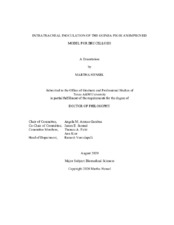| dc.description.abstract | B. melitensis is considered the most virulent of the Brucella species, and a need exists for an improved laboratory animal model of infection that mimics natural transmission and disease. Previous research has shown that guinea pigs are highly susceptible to infection with Brucella spp. and develop a disease syndrome that mimics natural disease after aerosol inoculation. Former aerosol studies utilized the Henderson apparatus, which is a device that fits over the head of the guinea pig to delivery an aerosol cloud. However, this route depends on the respiratory rate of the guinea pig and could lead to transfer of bacteria across mucosal membranes of the conjunctiva or oral cavity. In contrast, intratracheal inoculation is a means of generating aerosols that targets the respiratory tract and does not depend on the ventilation rate of the animal. As a targeted means of delivery, this route allows for the delivery of a defined dose to the lung with minimal losses. To first establish this delivery method, female, Hartley guinea pigs were infected via intratracheal inoculation with 16M B. melitensis. Guinea pigs developed fever between 12-17 days post-inoculation and had recoverable bacteria from the spleen, liver, lymph nodes, lung, and uterus with corresponding pathologic changes consistent with human brucellosis. After this proof of concept, pregnant guinea pigs were inoculated with 1x107 CFU B. melitensis IT, which demonstrated that in addition to fever, guinea pigs develop clinical signs of reproductive disease including stillborn fetuses and abortion. Finally, guinea pigs were vaccinated with either S19 or 16MvjbR to evaluate the pregnant guinea pig as a model for vaccine efficacy. This study demonstrated that offer an improvement over the mouse because clinical signs and systemic colonization can be evaluated. The work in pregnant guinea pigs indicate that they offer an improved animal model to investigate the reproductive pathogenesis of disease and are a valuable model to evaluate promising vaccine candidates. | en |


